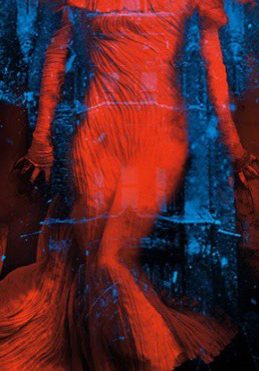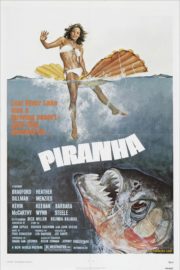Whispers of the Past: A Journey into Crimson Peak
“In my dreams, I see a red room. The walls are thick with blood.” This haunting quote from *Crimson Peak* encapsulates the film’s eerie atmosphere and the emotional landscape it navigates. Directed by Guillermo del Toro and released in 2015, *Crimson Peak* is a gothic romance that blends horror with rich visual storytelling. The film follows aspiring writer Edith Cushing (Mia Wasikowska) who is swept away to a decaying mansion in the English countryside by her enigmatic suitor, Thomas Sharpe (Tom Hiddleston). As she uncovers the dark secrets of both her husband and the haunted manor, one must question whether love can survive the weight of the past.
Crafting a Haunting Atmosphere
*Crimson Peak* excels in creating a horror atmosphere through its meticulous attention to detail and design. Del Toro’s vision manifests in an ambiance laden with suspense and foreboding, evoking a sense of dread that lingers throughout the film. The eerie opulence of Allerdale Hall, the Sharpe family home, plays a pivotal role in establishing this atmosphere. The mansion is akin to a character itself, breathing life into the narrative with its blood-red clay walls and terrors lurking in the shadows.
The sense of foreboding builds slowly as Edith discovers the mansion is not just a beautiful relic, but a realm tainted by tragedy. The combination of its creaking floorboards, ghostly whispers, and the stark realities of the Sharpe family history cast a chilling shadow over every scene, ultimately making the viewer question what lies in the dark corners of the psyche and the house itself.
The film’s horror is not merely bound to a singular element of shock or gore but deeply rooted in the emotional trajectory of its characters, enhancing the overall sense of unease. As shadows lengthen and spectral figures emerge, audiences are drawn into the depths of memory, trauma, and the ghostly remnants of lost love.
Visual Poetry: Del Toro’s Cinematic Touch
The cinematography in *Crimson Peak* is a breathtaking display of visual artistry. Del Toro’s collaboration with director of photography Dan Laustsen creates a unique aesthetic that draws the viewer into its lush, haunting world. The film employs a rich color palette dominated by deep reds, greens, and muted earth tones, reflecting both passion and decay. This carefully curated visual style captures the mood of gothic horror while also resonating with themes of love and loss present in the narrative.
Lighting plays a crucial role in shaping the film’s horror experience. Hazy, diffused light highlights the protagonist’s vulnerability, while harsh shadows accentuate the lurking dangers both within and outside of Allerdale Hall. The use of extreme close-ups and wide shots enhances the audience’s connection to character emotions and the overwhelming isolation of the mansion.
Furthermore, Del Toro’s signature special effects breathe life into the ghostly apparitions that haunt Edith. These ethereal figures are not just mere jump scares but manifestations of the characters’ inner demons, seamlessly combining practical effects with digital enhancements to enhance the haunting experience. The viewer is left with an unsettling realism that elevates the film beyond traditional horror.
The Sound of Horror: Soundtrack and Effects
The chilling soundtrack and sound design of *Crimson Peak* complement its gothic visuals beautifully, creating an immersive experience that heightens tension. Composer Fernando Velázquez crafts a score that ebbs and flows with the narrative, infusing scenes with increasing dread where necessary, while providing tender moments underscored by a melancholic resonance.
Sound effects play a crucial role in accentuating the atmosphere—and they often do so in subtle ways. The creaks of the floorboards, the echoes of whispers, and the rustle of fabric all contribute to the film’s immersive soundscape. Particularly effective are the moments of silence that precede shocking visuals—a tactic frequently used in horror to evoke heightened anticipation and fear. The lack of sound creates an increasingly tense space, only to be shattered by sudden screams or the abrupt appearance of a ghostly figure.
These auditory elements deepen the viewer’s emotional investment, which magnifies the film’s terror. Each sound, or the deliberate absence of it, is purposeful, ensuring that the audience’s heart races in tandem with Edith’s journey through despair.
Dynamic Performances in a Haunted World
The performances in *Crimson Peak* are meticulously crafted, lending a depth to each character’s experience of fear and love. Mia Wasikowska delivers a nuanced portrayal of Edith, capturing her transition from innocent naivety to a woman confronting her haunting realities. Her character’s evolution is marked by a fierce determination as she grapples with her own fears and the oppressive nature of her surroundings.
Tom Hiddleston embodies Thomas Sharpe with a blend of charm and mystery, making him an enigmatic figure whose true intentions remain ambiguous throughout the film. His performance captures the duality of love and danger that permeates the narrative, as he oscillates between being a protective husband and a potential threat.
Jessica Chastain, as Lucille Sharpe, gives a chilling performance filled with layers of tension and mental instability. Her portrayal of a complex antagonist is both unsettling and compelling, showcasing a deep understanding of the character’s motivations and past traumas. Together, the cast creates a palpable sense of dread, as their interactions and conflicts are steeped in a rich emotional context that enhances the film’s horror.
Exploring Horror Elements and Conventions
*Crimson Peak* skillfully intertwines various horror elements, primarily rooted in psychological and supernatural horror traditions. The film challenges the conventions of classic ghost stories by presenting spirits not merely as entities of terror but as representations of unresolved trauma and emotional burden. The ghosts serve as a bridge between the living and the dead, revealing the layered consequences of past actions.
Additionally, the film employs body horror to illustrate the physical and emotional toll of grief, regret, and betrayal. The manifestations of this horror are not limited to the spectral. Edith and the Sharpe family display signs of decay and despair, suggesting that emotional anguish can lead to physical deterioration. This commentary adds depth to the unfolding mystery of the house and its inhabitants.
Del Toro’s consideration of gothic motifs—such as forbidden love, family secrets, and the interplay of light and darkness—create a rich tapestry that adds to the horror experience. The film manages to articulate fears related to intimacy and vulnerability in a way that resonates on both personal and broader societal levels.
Methods of Fright: Psychological and Visual Shock
The film’s methods of frightening the audience vary between psychological manipulation and visual shocks, creating a balanced approach to horror. Much of the terror builds gradually; like the mansion itself, the film is layered with hidden fears that unveil themselves slowly, building tension until it becomes overwhelming. This method of slow revelation invites the audience to immerse themselves in the story and its characters, compounding the psychological impact of each revelation.
Sudden shocks are employed sparingly, ensuring they remain effective. The well-timed appearance of a ghost or a dramatic act creates moments that not only elicit screams but serve as plot progression. By juxtaposing quiet moments with bursts of frenetic energy, the film keeps the audience on edge, making them unable to predict when the next fright will occur.
Ultimately, the effectiveness of these techniques rests on their emotional engagement with the audience, allowing *Crimson Peak* to deliver a haunting yet human experience.
Layers of Meaning: Themes and Societal Commentary
Beneath the surface of its gothic romance, *Crimson Peak* is rich with thematic depth. The exploration of love is complicated by questions of authenticity, manipulation, and the haunting weight of the past. Edith’s journey serves as an allegorical exploration of how trauma shapes relationships and the individual.
The film also critiques the romanticization of suffering, emphasizing that love cannot thrive in a space filled with deception and sorrow. Del Toro builds layers of societal commentary, examining gender roles, repression, and the portrayal of women who contend with patriarchal forces. Edith’s writing and quest for independence reflect a challenge against a narrative that seeks to confine her.
By addressing these deeper issues, *Crimson Peak* transcends conventional horror tropes, resonating more profoundly with the audience while simultaneously delivering terror.
Final Thoughts: A Beautifully Crafted Horror Tale
As a horror film, *Crimson Peak* is ultimately a triumph, blending chilling ghost story elements with a character-driven narrative steeped in emotional complexity. Del Toro’s masterful craftsmanship and unique visual storytelling create a compelling atmosphere that both terrifies and captivates.
While the film may not cater to audiences expecting relentless action or grandiose jump scares, it enchants those who appreciate the nuanced interplay of love and horror, rooted in rich, atmospheric storytelling.
Horror aficionados will find much to appreciate in its artistic approach, while casual viewers may be drawn in by the stunning visuals and emotional depth. However, those who shy away from psychological horror or themes of decay should tread carefully, as the film includes moments that could prove distressing.
In summary, *Crimson Peak* stands as a testament to Del Toro’s vision, earning its place among contemporary horror masterpieces. Its haunting narrative, visual artistry, and emotional depth leave a lasting impression, inviting audiences into a world where love and terror intertwine—a world beautifully crafted but forever changed by its past.




